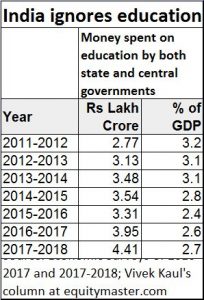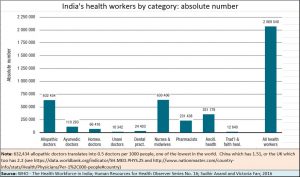http://www.freepressjournal.in/analysis/india-harms-its-demographic-dividend/1217369
India ignores its demographic dividend
— By | Feb 08, 2018 07:53 am
One would have thought that any government that was keen on improving the lot of its people would have focussed on two critical areas – education and healthcare. This would be more crucial when a government constantly talks about improving the demographic dividend that India enjoys.
Talk may be good and inspiring. But when it comes to actual numbers and investments, India cuts a very sorry picture.
 Consider education for instance. Even after survey after survey has talked about the pathetic state of India’s education – especially at the school level – India chose to allocate meagre resources towards this critically vital sector of the Indian economy. As against an expenditure of over 3% of GDP that the government used to spend on education, it spends barely 2.7% currently.
Consider education for instance. Even after survey after survey has talked about the pathetic state of India’s education – especially at the school level – India chose to allocate meagre resources towards this critically vital sector of the Indian economy. As against an expenditure of over 3% of GDP that the government used to spend on education, it spends barely 2.7% currently.
No government can improve education in the country by reducing the financial allocation for this extremely vital sector.
And the fact remains that India finds itself in a situation where barely 20% of its graduates is employable. And this does not come from any data the government provides. It comes from the reports of bodies like Nasscom, IBM, TCS and McKinsey. The need to upgrade India’s education – especially at the school level – is critically important. (http://www.asiaconverge.com/2017/08/good-moveson-the-education-front/).
Of course, India loves to fudge numbers. That could explain why Kapil Sibal, the former minister of education, tried to make promotion compulsory for all students till Std VIII. With one stroke of the pen, Sibal ensured that the enrolment figure for secondary level students would soar because of the automatic promotion stratagem (http://www.asiaconverge.com/2016/12/fudging-education-data-produces-sludge/). Mercifully, the present government has put a stop to that.
 But the desire to fudge data continues even today. That could explain why India’s bureaucrats have been persuading its legislators to allow all homeopaths and traditional medicine practitioners (Ayurved and Unani) to be treated as allopaths after they clear a bridge course.
But the desire to fudge data continues even today. That could explain why India’s bureaucrats have been persuading its legislators to allow all homeopaths and traditional medicine practitioners (Ayurved and Unani) to be treated as allopaths after they clear a bridge course.
The idea is laughable. Just ask the bureaucrats if they would like any ordinary clerk to become an IAS or an IRS officer by just clearing a bridge course? Or would the legislators like to be treated by doctors at the prestigious AIIMS by doctors who have been allowed to do a bridge course and become qualified as regular doctors. Or would the country allow court clerk to become a judge just by clearing a bridge course? The very proposal is absurd. Yet someone seriously thought it could be made law, and it is now being challenged before the Supreme Court.
In fact, if one looks at the number of doctors in India, it has just about 0.5 doctors for every 1,000 people. This is lower than China which has 1.51, or the UK which too has 2.2 (see https://data.worldbank.org/indicator/SH.MED.PHYS.ZS and http://www.nationmaster.com/country-info/stats/Health/Physicians/Per-1%2C000-people#country). Even if one were to consider all types of medical practitioners — allopathic, ayurvedic, homeopathic and unani – India would have just 0.79 doctors per 1,000 people. China would have 1.3. And yet, in spite of these pathetic numbers, the government now wants to launch healthcare for one-third of its economically poor population. But where are the doctors?
Once again, India’s policymakers have shown the world that they are quick to announce grandiose schemes without doing the required homework. The scheme is good,. It is laudable. But it needs people to be present in rural areas. A short-term move would be to make a six week exposure to rural health centres compulsory for every medical student. True the student would not have completed the course. But the student would be able to call up the college faculty and seek advice and help. The student would be familiar with basic hygiene and the ground rules for medicare. He would know where to send the patient in case there is an urgent need for expertise.
The long term solution would be to end the licence raj that surrounds the opening of medical colleges (many do make a lot of money by way of donations and capital fees). That would allow the number of graduates to swell. To ensure that the quality of education imparted is good, the government should have national qualifying examinations (on the same lines as the entrance examinations for engineering students). Colleges that don’t have the required facilities or the competence to teach, should be transferred from the bad management to one which has shown excellent management of educational standards.
That is the way to build healthcare capacity. And, yes, if there are more doctors, you can be sure that some will travel to other countries where there aren’t enough doctors. It would be part of India’s strategic advantage of being a manpower exporter as well.
As the figures show, India’s entire strategy in respect of education and medicare is woefully flawed. It appears to have lost perspective, and a sense of priority.
Talking about skill development is development is good, but not at the cost of good school education. All talk about universal medicare is excellent, but not without first working out the logistics of how to get the doctors to rural health centres. That is the job of the bureaucracy. And that is what it has not done. It has possibly misled the legislators. This needs to be rectified first.
Clearly, a little more of planning is required. And the sooner the government does this, the better.



































COMMENTS